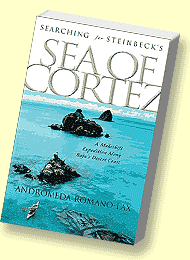
“Beneath
the bloodwarm and wind-stirred water, a psychedelic party was underway,
complete with disco-ball glitter. Colors flashed.
Fins whirred.
Surf broke against submerged rock, releasing clouds of bubbles.”
|
|
On
a map, Pulmo reef appears well within the Sea of Cortez. But actually,
oceanic influences -- deep swells and currents -- wrap around the
entire cape region and bring a taste of the open Pacific to the
reef’s backdoor. This was not the bathtub-calm gulf we’d
experienced farther north. These were panting, whirling waters;
an ecosystem on the dividing line. As always, that edge produced
an unparalleled richness.
Throughout our three-day visit, gusting afternoon winds textured
the sea’s surface. Even when the breezes died at dusk, waves
continued to break against the reef. With so much chop and without
the benefit of scuba-diving equipment or skills, we experienced
our best snorkeling from protected reef-facing beaches.
One of Pepe’s guides transported us by roaring panga to one
of these sandy coves. Tziporah had fallen asleep in the motorboat,
her face hidden under a hat. While Brian and Aryeh climbed over
the gunwales into knee-high water, I settled onto a panga bench
next to Tziporah, expecting to miss my first turn at snorkeling.
The guide smiled. “Go ahead,” he said, gesturing to the
water, and then to the napping toddler, curled up on the fiberglass
boat-floor. “I’ll watch her.”
Tentatively, I slid into the water, promising myself I’d snorkel
for just a minute or two, not more than a few feet from the boat.
But that was like saying one could slip into New York’s wildest
dance club and emerge before even the first song was over. Beneath
the bloodwarm and wind-stirred water, a psychedelic party was underway,
complete with disco-ball glitter. Colors flashed. Fins whirred.
Surf broke against submerged rock, releasing clouds of bubbles.
Needles of light flashed just under the surface. I steadied myself
in time to realize that a passing quicksilver sheet, so close to
the water’s mirrored ceiling that it looked like the ceiling
itself, was actually a small school of inch-long juvenile swordfish,
perfect miniatures of their predatory parents.
But the biggest surprise in this flashy place was the soundtrack.
Often, the underwater world is described as “silent.”
It’s not. As currents pushed and tugged, waves of sound washed
over me: the roiling pulse of moving water, a steady white-noise
static of shifting sand and coral debris, and a higher-toned click
and pop that I guessed to be shrimp. I added my own noises, inhaling
noisily and nervously through my snorkel, and making involuntary
grunts of surprise every time a fish careened within centimeters
of my mask, swept by an underwater current.
Above all this, I could hear the persistent scraping sound of a
dog worrying its bone. I followed the brittle gnawing to its source.
It turned out to be no dog, of course, but a parrotfish, grinding
its fused, beak-like teeth against the coral. In this way, it scrapes
edible algae from the rock. Sometimes it eats the living coral as
well. A single large parrotfish can pulverize a ton of coral reef
into sand in a year’s time.
Nearby, other tropical species probed and tore and circled the coral
-- idols and surgeonfish, triggerfish with sloping foreheads and
horse-like incisors, and blue damselfish, small but fiercely territorial.
A snorkeler from Cuba or Jamaica might recognize a third or more
of these species, which are twins (analogs) to Caribbean species.
Until 2 to 5 million years ago, the Cortez was connected to the
Caribbean by a natural rift through Central America -- the Panama
seaway. Since the seaway closed, species on both sides have continued
to evolve, making them distinct species. The idea of a Cortez-Caribbean
link was widely recognized only in the 1960s and 1970s; it would
have delighted Ricketts, who struggled to understand why, to a Californian,
the Cortez seems both familiar and exotic.
The diversity at Pulmo Reef astounded me. Until now in the Cortez,
I had snorkeled mostly among large schools of fish -- many fish
of one species, one school at a time, roving like hungry gangs above
the seabottom. Here, the fish intermingled in more complex patterns,
drawn into closer proximity by the coral. Aside from a lobster,
purple gorgonians, brown urchins, and the coral itself, I didn’t
see many of the smaller invertebrates, but I expected that they,
too, were here, probably burrowed under sand and rock to avoid the
maelstrom of current. The larger reef vertebrates so dazzled me
that I could not focus on any one thing for long.
Tropical fish colors -- turquoise, emerald, lemon yellow, stoplight
red -- drew me ever deeper, and made me forget, however briefly,
about my own need to breathe. Some of the fish were flat and round
like dinner plates, others were sleek and bullet-shaped. All wore
the round-eyed, purse-lipped expressions of the perpetually surprised.
Watching the fish, I could rarely hold my position for more than
five seconds before a rush of current sent me tumbling. There was
no point in kicking; the trick was to stay level and in place, to
avoid being washed sideways into rock or coral. Instead of actively
swimming, I simply sprawled, doing my best Peter-Pan-attached-to-guy-wires
imitation, using my hands and arms as hyperactive rudders. The fish,
I was surprised to see, did the same. Most of the each fish’s
whirring energies seemed spent not on forward motion, but on simple
re-orientation, a concept that might have had philosophical implications,
had I been quiet-minded enough to grasp them. As it was, I was plenty
busy just trying to float.
Every strong surge prompted a blurry burst of gyrations and flutterings;
platter-thin fish that had tipped completely on their sides would
rush to upright themselves, while barely avoiding collisions. I’d
imagined a tropical reef as a graceful and slow-moving place, an
underwater ballet comprised of a hundred smaller, purposeful motions.
Instead, I saw artful chaos -- Mobius Dance Company meets rush-hour
traffic. And still, out of all this confusion, a community thrived.
This was only the macro view. Closer in, I knew, there were even
more intricate dances, more intricate universes, to behold. A hawkfish
darted between the olive-colored folds of a branching stony coral,
and I strained to hold my breath and focus my vision, to follow
the fish’s red-spotted body through the metaphorical doorway,
into places I had never seen. But my lungs would have no part of
it. If a mouthful of plastic weren’t clogging my mouth, I would
have swore a blue streak then and there, cursing human anatomy.
Instead I simply surfaced and spit out my salty plug, gasping.
At Pulmo, Steinbeck and Ricketts were frustrated that they lacked
a simple good mask. I owned a good mask and snorkel, and was frustrated
that I hadn’t yet learned -- or mustered the courage -- to
scuba dive. Daytime scuba divers know that the real secrets await
in the dark; that’s when coral polyps extend a ring of tentacles
beyond their limestone skeletons and feed on passing zooplankton;
and that’s also when the night-shifters emerge -- moray eels
and grunts and big-eyed squirrelfish who sleep during the day. Round-the-clock
scuba divers go down into the greater depths, into the dark, and
curse the weight of their tanks and the fact that even they must
ultimately surface. All of us expect a grand vision just around
the corner. Every taste of wonder only sharpens our appetite for
more.
These were my thoughts as I fought the currents and labored to hold
my breath for longer and deeper dives. Then I remembered Tziporah,
and hurried back to the panga. After she woke up, I took her to
the soft white beach, where she stood, in about three inches of
deliciously warm water. It was barely enough water to cover my feet,
but enough to submerge her lower calves and convince her she was
practically swimming.
Aryeh had gone off snorkeling with Brian -- the first time all trip
that he was willing to put his face into the water. Tziporah was
too young even to try. But at Pulmo, there were tropical fish even
in these sandy shallows. She stood, happily pointing out the small
rainbow wrasses -- red- and yellow- and blue-striped -- that darted
past her ankles.
“There,” she said with a Buddha’s contentment. “And
there. And there... .”



Buy
it
Read
more:
All excerpts ©2002
Andromeda Romano-Lax
|










